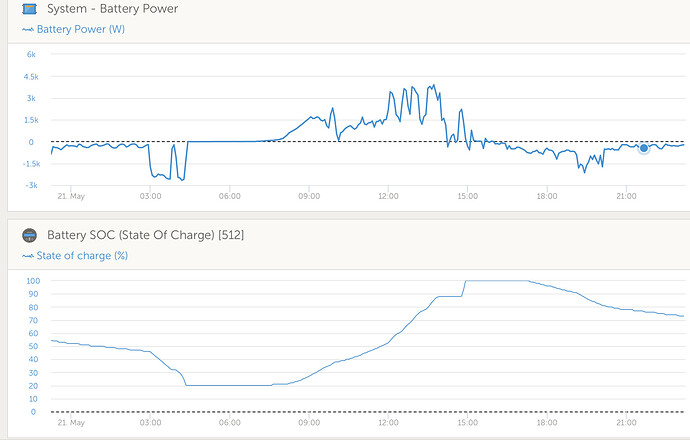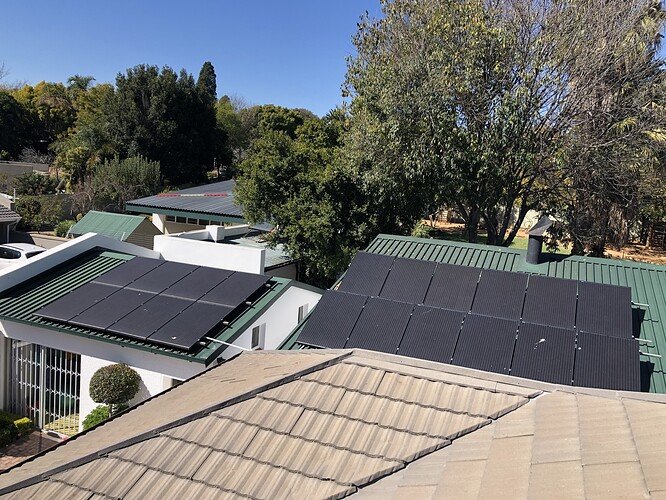My geysers already have solar tubes with geyserwise timers and 2000w elements.
I have read about simple systems using a dual element in the geyser, connecting the PV panels directly to the second element in DC. In theory, you do not lose any efficiency to down/up conversion and battery storage, and you store the solar energy in heat, not in batteries.
In theory you should be able to use a mechanical over temp cut-off, but I am not sure how that would last with DC.
I have three geysers, and I try to get them as hot as possible by day. But the long haired bipeds all shower in the morning and the early morning geyser reheating is killing my batteries (4x us3000 pylons).
If I can get the geysers up to 80c late afternoon, I would not need the early morning re-heating.
Trying to prevent:
- having to buy more batteries
- having to buy a fronius
Anybody with experience of a dual element for local geysers? Is it practical?
Firstly, do you usually have excess solar production?
In other words, do you find your MPPT(s) shutting off when there is plenty of sun during the day?
That SOC curve (if it’s typical) shows you are only hitting fully charged batteries at 15H00.
There isn’t much oomph, left in the sun after that time. (OK, I suppose it’s winter now).
But there is no point in thinking you are going to heat water without any excess power.
By the way, you are right about a typical geyser thermostat not lasting with DC, but there are workarounds.
You do get geysers with two elements. If you want to use a solar voltage for a second element you have to get an element with a much lower resistance than a typical 230V one. I think geyserwise does actually specialize in two-element (solar +230Vac) geysers. But, that will be an expensive solution.
I think there are probably simpler, cheaper solutions working with the gear you already have, but that’s if, and only if, you have excess solar power.
Panels are cheap - R25k for 4.5kwp. I was thinking of adding just panels and a dual element to the geysers x3.
Alternatively I have to get a Fronius 5k (R27k) or batteries (30k - 60k), or both, in addition to the panels, and that just doubles or triples the price.
Ever considered getting a heat pump?
1 Like
Heat pump x 3 will be more than a Fronius. And I fear their long term reliability.
1 Like
An anecdote:
I hate to make U-turns when I ask for directions. It’s my character flaw.
I have no sense of direction, but even my Garmin is set never to make U-turns.
My sense of direction is so bad, that the best time-saving device I possess is my satnav.
I’d be lost without it.
I think it’s because, making a U-turn to me is to admit to myself, that I wasn’t even half right. That I was actually destructive, not constructive. That I was better off staying put, not travelling at all, than getting further away from my destination.
Why the story?
You can likely raise your production 20% ish, without buying stuff and without changing usage habits. But it will mean being willing to reassess thinking and relooking at what you have.
These are things that you put a lot of time doing and are quite proud of.
I don’t want to upset you, so I’ll say this upfront.
Are you interested?
1 Like
You can retrofit the Geyserwise PTC AC/DC element for around R2500-R3000 per geyser.
I plan to use the load relay from my MPPT to switch on the DC element when there is excess PV, but that project is still a bit lower on the priorities list.
1 Like
What impresses me about this DC heating concept is it’s efficiency: Instead of converting the solar PV power to AC through an inverter (with all those losses) one drives the PTC element directly. If you look at their systems the maximum number of panels required is 4. They also use a MPPT to improve the power transfer to the element.
Very smart IMHO. So much so I bought the complete kit…
I’ll hit you with a bit of CS Lewis then. When you are (collectively) going the wrong way, the guy who turns around first is the most progressive.
I’m paraphrasing, but that is the gist of it. The context was a larger discussion about so called societal “progress”, that you don’t know whether you are making progress unless you know what the end goal is, something about which society can often be deliberately vague. I do however find it useful, in isolated form, to make myself feel better when I make a U-turn, in traffic or otherwise 
Ja but a panel only is max 20% efficient while direct Solar water heating using Sun is 70% or so…
@plonkster has the good stats and I think we had thread about this at some stage…
If you already have panels and there is excess PV then this is 20% extra.
Also the ease and cost of installation is much better.
PV modules are more like 17%. SWH is at least 60%, depending on flat panel, evacuated tube, etc. Simply has to do with what parts of the spectrum it can absorb. With PV modules, you are limited to the part of the spectrum that has enough energy to kick an electron out of orbit in a silicon atom 
Something else to be noted about using DC on a geyser element. It has to be impedance matched. PV modules are constant current devices. If you put your average 300W modules onto a geyser element, the max current that can push is 10A. If you have the standard 3kW element in there, that thing wants 13A (at 230V), so its around 18Ω. If you put a string of 10A-capable PV modules on it, the voltage will rise to 180V (10 times 18Ω) and you will make 180*10 = 1800W of hot-water-making-power.
Similarly, a 200W element has a resistance of 27Ω or so, so you need a PV module that makes around 8.7A and string enough of them together to get around 230VDC.
Which is why many solutions still include an MPPT (aka DC/DC converter), and simply drives the element directly from the other end. 95% conversion efficiency if done right (but still only 17% or so on the PV module).
That brings me to those PTC elements. Apparently really nice in that they don’t need a thermostat, they automatically increase resistance as they heat up. I’m just not sure how that’s going to work when driven by a PV module. Not only does it have to be impedance matched… the impedance changes through the day, slowing things down…
1 Like
My own philosophy about getting from A to B is also like driving. Steering around shallow bends, nudge a bit left here and a bit right there. That takes skill.
Even a young child can tell you you are going in the completely wrong direction, and they can’t even drive.
Racing lines.
I know this is completely off-topic, but one way I know if someone is an experienced driver is to compare how dirty the front wheels are vs the rear ones, that is how much brake dust is caked onto them. If the front ones are almost entirely black while the rear ones are shiny, that’s a driver who uses his brakes too much instead of holding momentum and choosing a better line 
1 Like
No way to re-plumb to only need one geyser for the bathrooms? What I intend on doing after my 200l (i have a 200 and a 100 in the house) packs up (which won’t be long) is to get one 250/300l geyser for the house on a heatpump and potentially get a 50l just for the kitchen (due to layout).
Unless you really need three geysers, you just sit with three sources of heat loss instead of one…
1 Like
I believe that this isn’t recommended. (citation needed)
If however you have a heat exchanger water heater then possibly…
@Ironman,
The first thing we need to is to define the problem and agree on what the problem is.
Can you be more specific about the above statement:
1.) What is the earliest time you need hot water 95% of the time?
2.) What energy source heats this water (Your batteries, ESKOM, solar PV or solar thermal?) and when does what energy source heat it (before or after use?).
Then we can see if the existing system can be re-jigged, to better get you what you need, when you need it. (Before throwing money at random solutions).
- first geyser: 4am. Second and third, from 6am
- two of my geysers have solar tubes:
But they are shaded from about 2pm in winter.
The rest of the energy comes from solar PV, Victron MPII 5000, in several non overlapping 1hour blocks per geyser during the day and then again from 3am for the first geyser and then my batteries are dead for the second and third geyser in winter.
In summer, there is more solar energy, incoming water temp is higher, required water temp is lower and heat loss is lower. In summer this system copes beautifully.
@Ironman
OK, next step, what do we have to work with?
May I see a rough diagram of your roof, ( with roof ridges, your PV and tubes( labelled Geysers 1&2)) indicating North and a rough idea of scale? Please draw in any shade producers in the garden and their approximate height above gutter level.
I understand you have 5kWp of 300W panels( 4 strings of 5 in series), a 250V/100A MPPT and a 5kW multi, am I correct?
Can you tell me an estimation of the volume of hot needed/geyser specific to geysers 1,2 & 3?
Edit: Are these 60 cell or 72 cell PV panels?
More photos should answer some of your questions:
Geysers get shaded from 14:15 and by 15:00 the tubes are all dark. The panels (20 x 300w = 6kwp) only get about 4200w max during winter due to non ideal angle. I lifted all the ones I could and this improved it from the 3700W max when they were all flat…
Edit: These 6kw panels also start getting shaded from about 15:45 and are all shaded by 16:15 in winter.
At the waaayyy back you can see another roof (with the red and yellow pipe on it) where I have more space, and much less shading but it is about 80m away.



